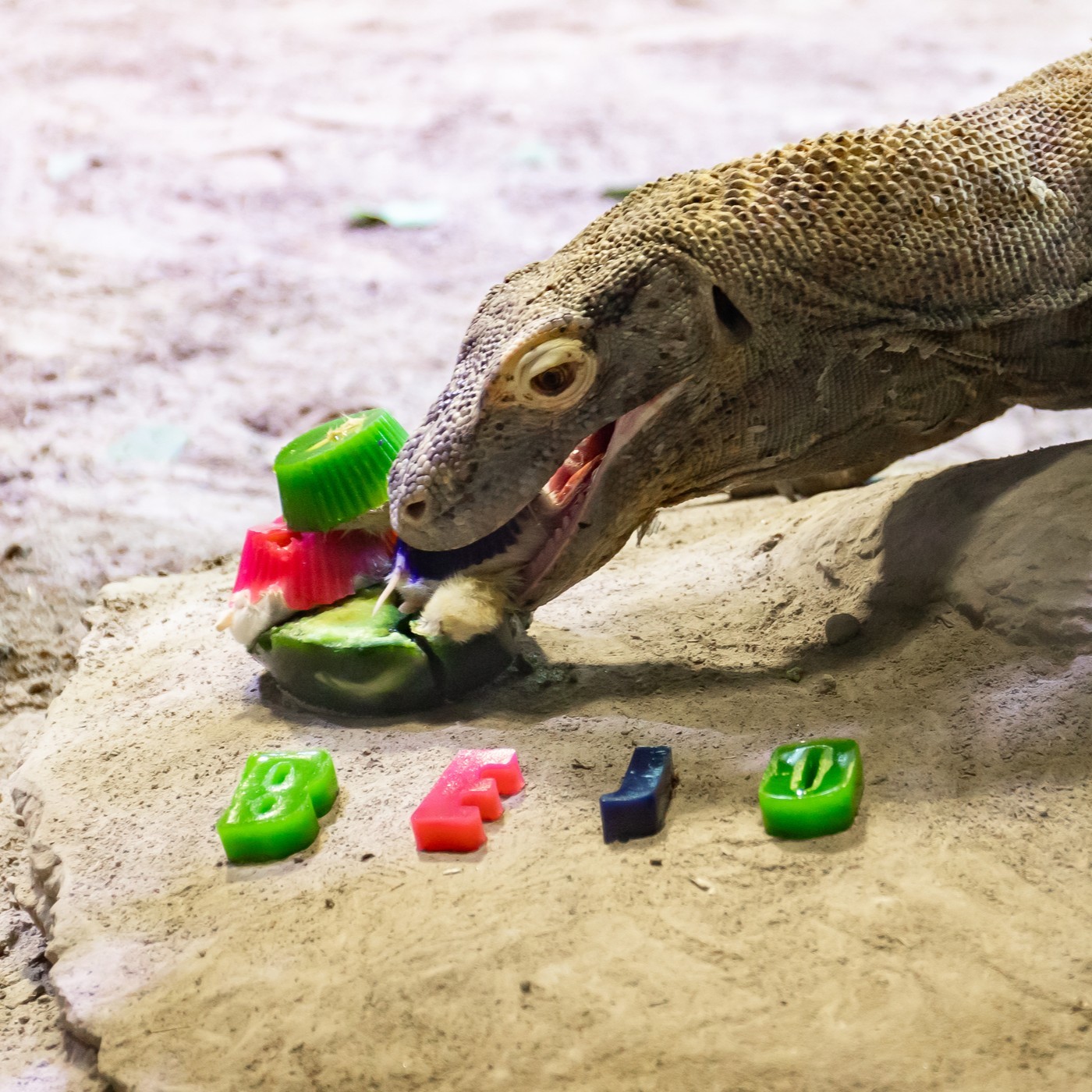Summary:
1. Introduction to the birthday celebration of the Komodo dragons
2. The uniqueness of Komodo dragons in the animal kingdom
3. Insights into the life and behavior of Komodo dragons
4. Conservation efforts for Komodo dragons and their natural habitat
5. Interesting facts and trivia about Komodo dragons
The 25 wasn’t the only one who enjoyed some birthday fun this summer – our two juvenile Komodo dragons celebrated their 7th Birthday recently with their own special Komodo-friendly cakes! Happy Birthday, Bejo and Kado! 🥳🐉🐉
Komodo dragons are truly magnificent creatures. They are the largest lizards in the world and possess some extraordinary features that make them unique in the animal kingdom. These formidable predators are native to the Indonesian islands of Komodo, Rinca, Flores, and Gili Motang. In this blog article, we’ll delve into the fascinating aspects of Komodo dragons, including their life, behavior, conservation, and some intriguing facts.
Let’s start with the basics. Komodo dragons, known as Komodo monitors, are reptiles from the Varanidae family. They are carnivorous apex predators, which means they sit at the top of the food chain in their ecosystems. Growing up to 10 feet in length and weighing around 150 pounds, these reptiles are truly massive. Their bodies are adorned with tough, scaly skin in shades of gray, brown, and green, allowing them to blend seamlessly into their surroundings.
Komodo dragons possess an incredible sense of smell, enabling them to detect carrions up to 2.5 miles away. Despite their massive size, they can reach impressive speeds of up to 12 miles per hour for short distances. This impressive agility and speed make them formidable hunters.
As solitary creatures, Komodo dragons spend most of their time alone. They are territorial and mark their territories with scent and visual displays. Their habitat mainly consists of dry savannas, tropical forests, and mangrove swamps. These habitats provide them with ample opportunities to hunt and find shelter.
Feeding on a variety of prey, Komodo dragons are opportunistic hunters. While they primarily feed on carrion, they also prey on deer, pigs, and water buffalo. Their hunting technique involves patiently waiting for unsuspecting prey to pass by before ambushing them with a sudden burst of speed. Once caught, the Komodo dragon utilizes its powerful bite, inflicting deep wounds. The saliva of Komodo dragons is highly toxic, containing a cocktail of bacteria that can incapacitate and eventually kill their prey. This venomous bite is followed by relentless stalking until the prey succumbs to its injuries.
Although Komodo dragons are known for their ferocity, they exhibit unique behaviors. Female Komodo dragons are known to be attentive and careful mothers, guarding their nests and protecting their hatchlings for the first few months. Komodo dragons are also capable of parthenogenesis, a form of asexual reproduction where females can lay fertile eggs without mating.
As fascinating as these creatures are, their survival in the wild is significantly threatened. Human activities such as habitat destruction, poaching, and climate change pose severe risks to the Komodo dragon population. As a result, conservation efforts have been put in place to protect these magnificent reptiles and their natural habitat.
Reintroduction programs have been initiated to increase their numbers in the wild. Protected areas, including Komodo National Park, have been established to safeguard their habitats and promote research on their ecology and behavior. These conservation initiatives are crucial in ensuring the long-term survival of Komodo dragons and maintaining the delicate balance of their ecosystems.
Now, let’s dive into some intriguing facts and trivia about Komodo dragons that will surely captivate your imagination:
1. Komodo dragons have a unique adaptation that allows them to reproduce asexually, making them one of the few species capable of this form of reproduction.
2. The prey of Komodo dragons, when bitten, succumbs to the venomous saliva and the massive amounts of bacteria in the dragon’s mouth.
3. Komodo dragons can consume up to 80% of their body weight in a single feeding, much more than any other carnivorous reptile.
4. The sense of smell in Komodo dragons is highly advanced, and they can detect the scent of decaying flesh from several miles away.
5. Komodo dragons have been a subject of fascination and myth for centuries, often associated with the legendary dragons of folklore.
In conclusion, Komodo dragons are remarkable creatures deserving our admiration and protection. Their size, strength, and unique adaptations make them a fascinating species. By understanding their behavior, preserving their habitats, and supporting conservation efforts, we can ensure the survival of these magnificent predators for generations to come. Happy Birthday to our beloved Bejo and Kado, and may their existence serve as a reminder of the wonders of the natural world!
*****
Source Description
25 wasn’t the only one who enjoyed some birthday fun this summer – our two juvenile Komodo dragons celebrated their 7th Birthday recently with their own special Komodo-friendly cakes! Happy Birthday, Bejo and Kado! 🥳🐉🐉


